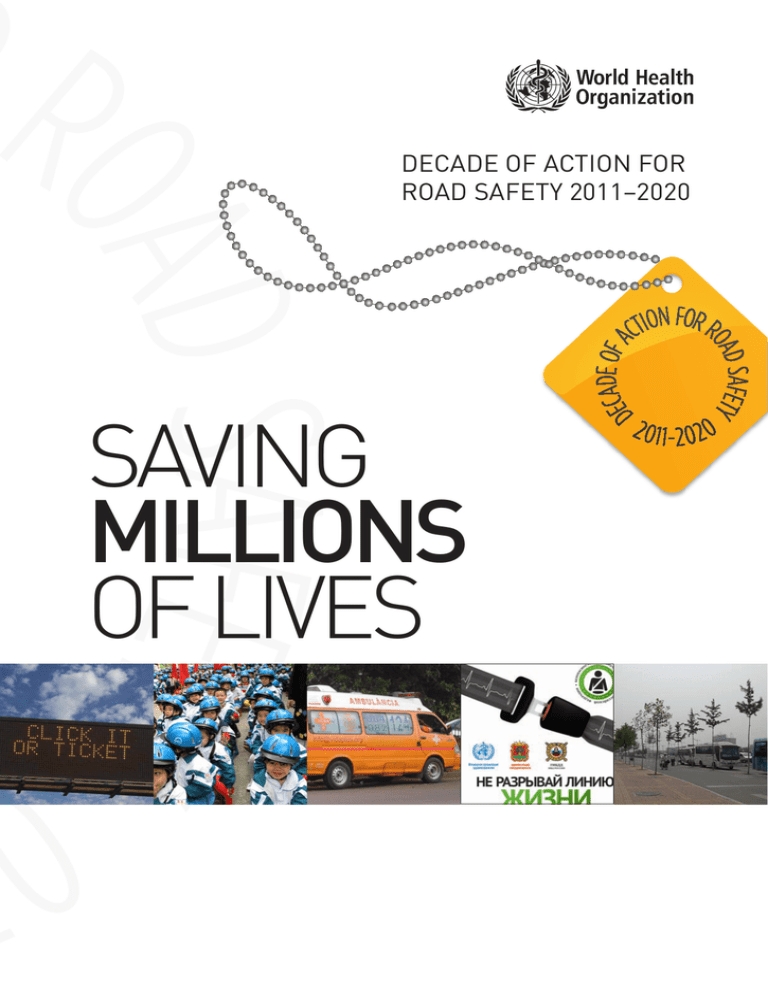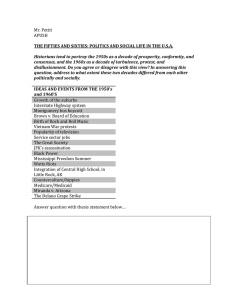
DECADE OF ACTION FOR
ROAD SAFETY 2011–2020
SAVING
MILLIONS
OF LIVES
Why this document?
For many years road traffic crashes have been acknowledged by the
United Nations and its Member States to be a considerable challenge
to the achievement of health and development goals. It has only
been during the past decade, however, that the issue has gained the
prominence it deserves among the world’s most pressing international
health and development concerns. Following the highly successful First
Global Ministerial Conference on Road Safety hosted by the Government
of the Russian Federation in November 2009, a Decade of Action for
Road Safety 2011–2020 was officially proclaimed by the United Nations
General Assembly in March 2010. This document offers some key
information about the Decade and WHO’s role.
Acknowledgements
WHO wishes to thank Bloomberg Philanthropies, FIA Foundation and
the United States Centers for Disease Control and Prevention for their
generous financial support for the development and publication of this
document.
2
Decade of Action for Road Safety 2011–2020 Saving millions of lives
Key facts
• Road traffic crashes take the lives of nearly 1.3 million people every year, and injure 20–50 million more.
• Road traffic injuries have become the leading cause of death for people aged 15–29 years. • Over 90% of road traffic deaths and injuries occur in low-income and middle-income countries,
which have only 48% of the world’s registered vehicles.
• Nearly half (46%) of those dying on the world’s roads are “vulnerable road users”: pedestrians,
cyclists and motorcyclists.
• In addition to the grief and suffering they cause, road traffic crashes result in considerable
economic losses to victims, their families, and nations as a whole, costing most countries
1–3% of their gross national product.
• Without action, road traffic crashes are predicted to result in the deaths of around 1.9 million
people annually by 2020.
• Only 15% of countries have comprehensive laws relating to five key risks: speeding, drinking
and driving, and the non-use of helmets, seat-belts and child restraints.
Top 10 leading causes of death, 2004 and 2030 compared
2004
Rank
Disease or injury
2030
Rank
Disease or injury
1
Ischaemic heart disease
1
Ischaemic heart disease
2
Cerebrovascular disease
2
Cerebrovascular disease
3
Lower respiratory infections
3
Chronic obstructive pulmonary disease
4
Chronic obstructive pulmonary disease
4
Lower respiratory infections
5
Diarrhoeal diseases
5
Road traffic injuries
6
HIV/AIDS
6
Trachea, bronchus, lung cancers
7
Tuberculosis
7
Diabetes mellitus
8
Trachea, bronchus, lung cancers
8
Hypertensive heart disease
9
Road traffic injuries
9
Stomach cancer
10
Prematurity & low-birth weight
10
HIV/AIDS
3
Road traffic injury fatality ratesa per 100 000 population, by WHO region and income
group
WHO region
High-income
Middle-income
Low-income
Total
African
—
32.2
32.3
32.2
The Americas
13.4
17.3
—
15.8
South-East Asia
—
16.7
16.5
16.6
European
7.9
19.3
12.2
13.4
Eastern Mediterranean
28.5
35.8
27.5
32.2
Western Pacific
7.2
16.9
15.6
15.7
10.3
19.5
21.5
18.8
Global
30-day definition of a road traffic death
Source: Global Status Report on Road Safety, 2009
a
Population, road traffic deathsa, and registered motorized vehicles, by income group
Population
Road traffic deathsa
HIC
HIC
LIC
15.6%
LIC
8.5%
9.2%
LIC
41.9%
36.7%
MIC
47.8%
a
Registered vehicles
MIC
MIC
38.7%
HIC
52.1%
49.6%
30-day definition, modelled data. HIC = high-income countries; MIC = middle-income countries; LIC = low-income countries
For more key facts, visit:
Global status report on road safety 2009
http://www.who.int/violence_injury_prevention/road_safety_status/2009/en/index.html
Global Health Observatory road safety
http://www.who.int/gho/road_safety/en/index.html
4
Decade of Action for Road Safety 2011–2020 Saving millions of lives
Decade of Action for Road Safety
2011-2020
A Global Plan for the Decade of Action for Road Safety 2011–2020 has
been drawn to guide efforts at national and local levels. If the Global
Plan is successfully implemented, the Decade could achieve its goal to
stabilize and then reduce the forecasted level of road traffic fatalities
around the world. If this ambitious target is achieved, a cumulative total
of 5 million lives, 50 million serious injuries and US$ 5 trillion could be
saved over the Decade.
Decade of Action for Road Safety 2011-2020: saving millions of lives
Projected increase
without action
2.0
1.8
Number of deaths (millions)
1.6
5 million lives saved
1.4
1.2
1.0
0.8
Projected
reduction if
action taken
0.6
0.4
0.2
0
2011
2012
2013
2014
2015
2016
2017
2018
2019
2020
Year
5
Global Plan
for the Decade of Action for
Road Safety 2011–2020
6
Pillar 1
Road safety management
Pillar 2
Safer roads and mobility
Pillar 3
Safer vehicles
This pillar focuses on the need
to strengthen institutional
capacity to further national
road safety efforts. It includes
activities such as putting into
practice major United Nations
road safety conventions;
establishing a lead agency
for road safety in the country
involving partners from a range
of sectors; developing a national
road safety strategy; and
setting realistic and long-term
targets for related activities
with sufficient funding for their
implementation. It also calls for
development of data systems to
monitor and evaluate activities.
This pillar highlights the need
to improve the safety of road
networks for the benefit of
all road users, especially the
most vulnerable: pedestrians,
bicyclists and motorcyclists.
Activities include improving
the safety-conscious planning,
design, construction and
operation of roads; making
sure that roads are regularly
assessed for safety; and
encouraging relevant authorities
to consider all forms of
transport and types of safe
infrastructure when they
respond to the mobility needs of
road users.
This pillar addresses the need
for improved vehicle safety by
encouraging harmonization of
relevant global standards and
mechanisms to accelerate the
uptake of new technologies
which impact on safety.
It includes activities such
as implementing new car
assessment programmes so
that consumers are aware of
the safety performance of
vehicles, and trying to ensure
that all new motor vehicles are
equipped with minimum safety
features, such as seat-belts.
Other activities covered include
promoting more widespread use
of crash avoidance technologies
with proven effectiveness,
such as electronic stability
control and anti-lock braking
systems. Managers of fleets are
also encouraged to purchase,
operate and maintain vehicles
that offer high levels of
occupant protection.
Decade of Action for Road Safety 2011–2020 Saving millions of lives
Pillar 5
Post-crash response
This pillar focuses on developing
comprehensive programmes to
improve road user behaviour.
Activities include encouraging
the development and adoption
of model road safety legislation
and sustained or increased
enforcement of road safety laws
and standards. These efforts are
combined with public awareness
and education to increase seatbelt and helmet wearing and
to reduce drinking and driving,
speeding and other risks. It also
calls for activities to reduce
work-related road traffic injuries
and promotes the establishment
of graduated driver licensing
programmes for novice drivers.
This pillar promotes the
improvement of health and
other systems to provide
appropriate emergency
treatment and longer-term
rehabilitation for crash victims.
Activities include developing
pre-hospital care systems,
including implementation of a
single nationwide telephone
number for emergencies;
providing early rehabilitation
and support to injured patients
and those bereaved by road
traffic crashes; establishing
insurance schemes to fund such
initiatives; and encouraging
a thorough investigation into
crashes and an appropriate legal
response.
Global Plan
Pillar 4
Safer road users
For the full version of the Global Plan, visit:
http://www.who.int/roadsafety/decade_of_action/plan/en/index.html
The Global Plan for the Decade of Action for Road Safety
2011–2020 was developed by the United Nations Road Safety
Collaboration (UNRSC) and stakeholders from around the world.
To achieve its goal, the Global Plan features five categories or
“pillars” of activities which are described below. Indicators have
been developed to measure progress in each of these areas.
7
Implementing the Global Plan
for the Decade of Action for Road
Safety 2011-2020
There is strong evidence about what works to prevent road traffic deaths
and injuries. The Global Plan is based on the best evidence of what works
given successful experiences from a number of countries. Here are some
examples below.
Australia ­
Reducing drinking and driving through random breath testing
Consuming alcohol before driving increases the risk of a crash as well as the likelihood that death
or serious injury will result. Passing a drinking and driving law and enforcing it can reduce the
number of road deaths by around 20%. Random breath testing is the primary drinking and driving
law enforcement tool used throughout Australia. The police can stop and perform a breath test
on a driver at any time, irrespective of their driving behaviour. Highly visible “booze buses” are
used to conduct testing while media campaigns support enforcement. The evaluation of random
breath testing has shown long-term reductions in alcohol-related crashes.
Effectiveness of random breath testing on alcohol-related crashes in Australia
% of fatally injured motorists
with BAC ≥ 0.05 g/dl
50
45
40
35
30
25
20
15
10
5
Source: Department of Infrastructure, Transport, Regional Development & Local Government, 2009
8
2006
2005
2004
2003
2002
2001
2000
1999
1998
1997
1996
1995
1994
1993
1992
1991
1990
1989
1988
1987
1986
1985
1984
1983
1982
1981
0
Decade of Action for Road Safety 2011–2020 Saving millions of lives
France
Charting progress over decades
Since the early 1970s, France has made great strides in reducing fatalities on the nation’s roads.
This has been the result of myriad factors, including adoption and enforcement of legislation on
speeding, seat-belts and drinking and driving. Since 2002, a combination of factors including
a stated commitment from the highest level of government, stricter enforcement of legislation
especially through the use of speed cameras, and media campaigns explaining the traffic rules
and risks has accelerated the decrease in annual fatalities. From the early 1970s to 2009, deaths
have declined from more than 16000 annually to just over 4000 annually.
Evolution of the number of annual road traffic deaths in metropolitan France, 1970–2009
Jun 1973 • Speed limits 110 km/h on
roads with heavy traffic and
100 km/h on other roads • Seat-belts mandatory for front
seat passengers outside urban
areas
• Helmet mandatory
Jul 1978
Law on drinking and
driving prevention
16 000
12 000
10 000
8 000
6 000
4 000
2 000
Nov 1974
General speed
limits: • 90 km/h on
departmental
roads • 110 km/h on dual
carriageways • 130 km/h on
motorways/
highways
Oct 1979
Seat-belt
mandatory
for front seat
passengers
in urban
areas
Change of definition
Since January 2005, the
definition of a road traffic
death has changed to
include deaths for up to
30 days after the crash
(instead of 6 days)
Dec 1990
•Speed limit of 50 km/h in
urban areas
•Seat-belts mandatory for
back seat passengers
14 Jul 2002
Statement of the
President of the Republic
Dec 1983
Alcohol: • BAC limit
set at
0.08 g/dl
blood
Jul 1992
Introduction
of the driver
licensing
point
system
Sep 1995
Alcohol: • BAC limit
set at 0.05 g/dl
blood
Nov 2003
Introduction
of speed
cameras
0
Dec 1970
Dec 1971
Dec 1972
Dec 1973
Dec 1974
Dec 1975
Dec 1976
Dec 1977
Dec 1978
Dec 1979
Dec 1980
Dec 1981
Dec 1982
Dec 1983
Dec 1984
Dec 1985
Dec 1986
Dec 1987
Dec 1988
Dec 1989
Dec 1990
Dec 1991
Dec 1992
Dec 1993
Dec 1994
Dec 1995
Dec 1996
Dec 1997
Dec 1998
Dec 1999
Dec 2000
Dec 2001
Dec 2002
Dec 2003
Dec 2004
Dec 2005
Dec 2006
Dec 2007
Dec 2008
Dec 2009
Annual number of road traffic deaths
14 000
Oct 1990 Random breath
testing initiated
by the police
Source: Graphique reproduit avec l’autorisation de l’Observatoire national interministériel de la sécurité routière (ONISR), France
9
Ghana
Until the early 2000s, emergency trauma care in
Ghana was informal and extremely limited. Most
patients injured in a road crash were taken by
their relatives to a health facility where they would
receive limited first aid. In 2001, efforts to address
emergency trauma care gained political support. In
2004 the government established a nationwide ambulance
and
a dedicated
An EMTservice
checking the
vital signs
of a Patient inemergency
the Ambulance as
part of ongoing Assessment
hotline. In less than four years:
• the number of cases handled by the national ambulance system rose from 205 in 2004 to
8250 in 2008;
• the average response time for ambulances decreased from 17 minutes in 2006 to 13 minutes
in 2008; and
• the average time spent at the scene decreased from 19 minutes in 2006 to 14 minutes in 2008.
Malaysia
© K Rajam/WPRO
Modifying road infrastructure to improve safety
10
Separating different types of vehicles, for example,
two and three wheeled vehicles from four or more
wheeled vehicles is a proven intervention to reduce
road traffic crashes. Exclusive motorcycle lanes are
a means to do so. These lanes are dedicated solely
for use by vehicles such as motorcycles, scooters
and bicycles. They are becoming common in a
number of Asian cities, where they have proven
to dramatically reduce collisions and resultant
injuries by creating safer driving environments for
all road users. For example, evaluation of the Federal
Highway Route 2 in Malaysia which includes an exclusive motorcycle lane revealed that crashes
were reduced by 39% after this lane was built. © AN Zakariah/GAS
Establishing a nation-wide
ambulance service
Decade of Action for Road Safety 2011–2020 Saving millions of lives
United States of America
Increasing seat-belt wearing through the “Click It or Ticket”
campaign
Lives saved by seat-belts, USA, 2000–2009
Lives saved
Wearing a seat-belt reduces the risk of
being ejected from a vehicle and suffering
serious or fatal injury by between 40%–
65%. Click It or Ticket is the most successful
seat-belt enforcement campaign ever
conducted in the country. The cornerstone
of the campaign is the national Click it or
Ticket May Mobilization, during which law
enforcement agencies join forces across
the country. Their efforts are supported by
national and local media campaigns. From
2000–2009, over 140 000 American’s
lives were saved by seat-belts.
18 000
16 000
14 000
12 000
10 000
8 000
6 000
4 000
2 000
0
2000 2001 2002 2003 2004 2005 2006 2007 2008 2009
2000 2001 2002 2003 2004 2005 2006 2007 2008 2009
Year
Source: http://www-nrd.nhtsa.dot.gov/
Viet Nam
Research has shown that correctly wearing a
motorcycle helmet can cut the risk of death by 40% and reduce the risk of serious head injuries by 70%.
In 2007 the Government of Viet Nam passed a law
requiring all motorcycle drivers and passengers to
wear helmets. Strict enforcement of this law by
police around the country led to a tripling in helmet
wearing rates, reaching over 90% among both drivers and passengers. Within a year of the
Government’s decision, police had intensified their enforcement and the fines for not wearing a
helmet had increased substantially, while hospitals reported a 16% reduction in the risk of a head
injury compared to the previous year. Police reports show that over 1500 lives were saved and
over 2500 serious injuries prevented in the year after the helmet law was passed. Motorcycles
comprise 95% of all registered vehicles in Viet Nam, and this policy on helmet use is therefore
likely to have contributed significantly to these positive road safety benefits.
© WHO/M.Peden
Improving helmet-wearing rates
through enforcement of legislation
11
WHO’s contributions to the
Decade of Action for Road Safety
2011-2020
WHO will support implementation of the Global Plan for the Decade of
Action for Road Safety 2011–2020. Below are descriptions of some of
the ways WHO plans to be involved in the coming years.
Coordinating global efforts
WHO, in collaboration with the United Nations regional commissions, is the coordinator of
road safety across the United Nations system. In this regard WHO acts as the secretariat for
the United Nations Road Safety Collaboration (UNRSC), a network of 60 governments, United
Nations agencies, nongovernmental organizations, foundations and private companies. Across
the Decade, the UNRSC will be instrumental in guiding global efforts by continuing as it has since
2004 to advocate for road safety at the highest political levels; compile and disseminate good
practices in prevention; share information with the public on risks and ways to mitigate those;
and draw attention to the need for increased funding. The UNRSC will coordinate and plan the
key milestone events of the Decade.
Monitoring progress through global status reports
While the UNRSC will be in charge of evaluating the overall impact of the Decade, WHO will
provide one of the tools for doing so through its status reports. The Global status report on road
safety, published in 2009, provided the first comprehensive assessment of the road safety
situation globally. With data from 178 Member States, the report continues to be a reference for
policy-makers, practitioners and the media and serves as a catalyst for change in many countries.
These status reports collect information on the number and rates of fatalities; the existence of
national strategies and targets; legislation and enforcement on a number of key risks; and the
current state of post-crash care. The forthcoming Global status report on road safety, to be released
on 2012, will serve as a baseline for monitoring activities relating to the Decade, with subsequent
reports published every two years.
Supporting road safety programmes in countries
In 2010, WHO and five other consortium partners received funding from Bloomberg Philanthropies
to further road safety in ten countries. Dubbed the Road Safety in 10 Countries (RS10) Project,
this initiative supports the governments of Brazil, Cambodia, China, Egypt, India, Kenya, Mexico,
the Russian Federation, Turkey and Viet Nam. In all countries, the RS10 Project focuses on
selected key risks for road traffic crashes. For example, the focus in Kenya is on helmets and
speeding; in Mexico on seat-belts and drinking and driving; and in the Russian Federation on
seat-belts and speeding. Efforts are focused on strengthening legislation and enforcement and
12
Decade of Action for Road Safety 2011–2020 Saving millions of lives
educating the public through social marketing campaigns. WHO also supports road safety efforts
in other countries such as Malawi and Mozambique to improve safety around schools. Over the
Decade, WHO will continue to support these and other national road safety initiatives leading to
sustainable government programmes.
Helping to improve emergency services
Another important contribution to the Decade will be WHO’s support as part of the RS10 Project
to pilot projects to improve emergency services in India and Kenya. In addition WHO is working
with a number of partners to create the Global Alliance for the Care of the Injured. The partners
involved in this nascent network have been instrumental in producing many of the guides released
by WHO and others in recent years.
Building capacities
Through the RS10 Project and other national road safety initiatives, WHO will support the
building of capacities among WHO staff and its partners to design, implement and evaluate
road safety programmes. As part of these broader capacity building efforts, doctors are trained
to more accurately prepare death certificates, journalists are trained to better report on road
traffic crashes, and staff from nongovernmental organizations are trained to strengthen their
collaboration with the media. Road safety is also an important component of TEACH-VIP and
MENTOR-VIP, two WHO-led capacity building efforts. Supporting nongovernmental organizations
In recent years, WHO has increasingly recognized the value of nongovernmental organizations, in
particular in the area of advocacy. Such groups are key to increasing political will and generating
a demand from the public for safer roads. Across the Decade WHO will support a strategic
approach to advocacy by such groups. WHO will also support establishment of a more formal
global network of nongovernmental organizations to support implementation of the Global Plan.
WHO global and regional focal points for the Decade
To contact WHO headquarters and regional office focal points for the Decade, visit:
http://www.who.int/roadsafety/decade_of_action/focal/who_regional_offices/en/index.html
13
What can you do to support the
Decade of Action for Road Safety
2011-2020?
The Decade of Action for Road Safety 2011–2020 is everybody’s Decade.
We all have an interest in ensuring that the vision of the Decade becomes
a reality. Below are some ideas for what you might do to support the
Decade.
Policy-makers:
• release national or local plan in line with the Global Plan;
• enact new legislation or improve enforcement of existing legislation;
• ensure funds to support the national plan.
Nongovernmental organizations:
• create awareness raising tools;
• organize high-profile public events;
• influence the creation or modification of legislation.
Private companies:
• release a fleet safety policy;
• support campaigns in the communities in which the company operates;
• contribute financially to the Road Safety Fund.
Young people:
• serve as “ambassador” for road safety;
• join a youth assembly;
• ensure the safety of roads around schools.
Victims and survivors:
• share stories of the consequences of road crashes;
• host an event on the annual World Day of Remembrance for Road Traffic Victims;
• support nongovernmental organizations.
Media:
• commit to reporting news and features on road safety;
• report responsibly on road traffic crashes, using reports on crashes as an opportunity to
address prevention;
• serve as a conduit for social marketing and mass media campaigns. 14
Decade of Action for Road Safety 2011–2020 Saving millions of lives
A symbol for all: the road safety “tag”
The road safety “tag” is the new global symbol for road safety and
the key visual for the Decade of Action for Road Safety. It will unite
efforts which take place in the context of the Decade. A promotional
web site for the tag encourages groups marking the launch of the
Decade to “Wear. Believe. Act.” by wearing the road safety tag and
displaying it on advocacy materials for Decade-related events;
reflecting on the impact of road traffic crashes and the possibilities
for prevention; and taking action to ensure greater safety on the
roads. To purchase the tag as a wearable or decorative item, request
the artwork for printed materials or contribute financially to the
newly established Road Safety Fund, visit:
http://www.decadeofaction.org
Photo credits for title page: ©iStockphoto.com; ©WHO/M. Peden; ©WHO/K. Bartolomeos; ©WHO Russia; ©WHO/ K. Rajam. Page 13: © Pedro Costa/Lusa;
© PAHO; © WHO/M. Peden; © PAHO. Back cover: ©Make Roads Safe campaign; ©WHO; ©Make Roads Safe campaign; ©Make Roads Safe campaign; ©Bloomberg
Philanthropies
15
Recognition is growing about the critical development and public health
challenge posed by road traffic deaths and injuries. I call on Member States,
international agencies, civil society organizations, businesses and community
leaders to ensure that the Decade of Action for Road Safety leads to real
improvements.
Mr Ban Ki-moon
Secretary-General, United Nations
The Decade of Action for Road Safety creates the political platform needed to
scale up some well-defined measures. Evidence tells us that these measures
work, and can save millions of lives.
Dr Margaret Chan
Director-General, World Health Organization
It is time for those who can make a real difference to step up to meet this
challenge and to commit to the Decade of Action for Road Safety.
The Most Reverend Desmond Tutu
Archbishop Emeritus of Cape Town
By making road safety a priority over the Decade of Action for Road Safety,
we have the potential to save millions of lives, and to prevent many millions of
injuries and disabilities.
Ms Michelle Yeoh
Actress and Global Ambassador for the Make Roads Safe Campaign
Too many people are killed or injured on the world’s roads. The World Health
Organization predicts that road traffic injuries will rise to become the fifth
leading cause of death by 2030. The time is now to commit to action. The
Decade of Action for Road Safety has the potential to save millions of lives.
Mr Michael Bloomberg
Mayor of the City of New York
DECADE OF ACTION FOR
ROAD SAFETY 2011–2020
www.who.int/roadsafety/decade_of_action
WHO/NMH/VIP 11.07
© World Health Organization 2011. All rights reserved.





